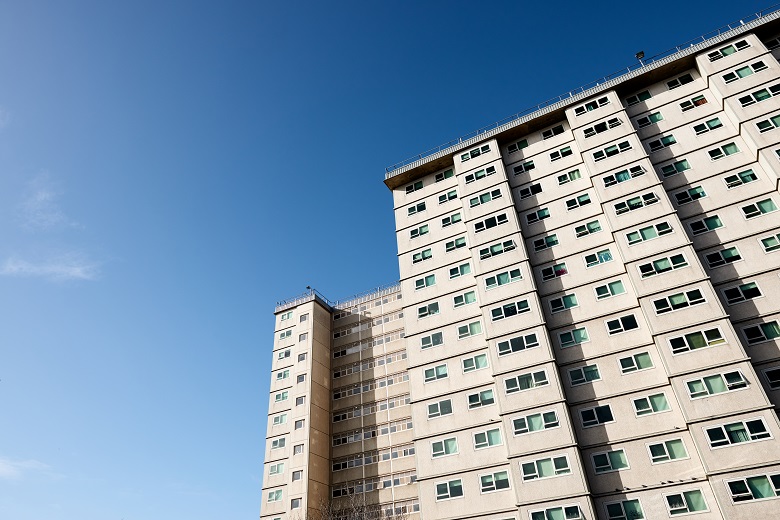
Policies designed to encourage social housing clients to transition out of the system may actually be contributing to the backlog in waiting lists, a social housing expert says.

New research from the Australian Housing and Urban Research Institute (AHURI) shows that social housing applicants can spend up to ten years on waiting lists and says policies are more focused on managing the queue than meeting the needs of tenants.
Separate government statistics released by the AIHW show 803,900 Australians were living social housing in 2017-18. The report said more than a quarter of those considered in greatest need had to wait more than a year, while half of those not in greatest waited more than two years before being allocated housing.
Dr Chris Martin, a Senior Research Fellow with the UNSW City Futures Research Centre who contributed to the AHURI report, says a fixation with moving people out of the system has resulted in increasing surveillance of households, which have become increasingly required to report on income and undergo ongoing eligibility checks.
“The intention has been if people increase their income they should be made to move out of social housing,” Dr Martin told Government News.
“But I think more likely it’s had the opposite effect – it means people will may be discouraged from taking up opportunities that may come up to increase their income.”
The constant surveillance may also affect decisions about who joins a household, or whether an adult child is encouraged to leave the household when they start earning money.
A false economy
“This idea that has taken hold recently … that there’s a continuum in social housing and a transition from crisis housing, to social housing to public rental, is a false idea,” Dr Martin says.
“Tyring to pursue that false idea that people are transitioning has meant that ironically households don’t move so often, that they freeze up the system because they are discouraged from taking up opportunities.
“The idea of social housing being this transitional thing, and that policies always need to keep watching people and moving them on, I think that definitely needs to be revisited and re-thought, because it is actually doing damage.”
The AHURI report, The construction of social housing pathways across Australia released this month, says a positive outcomes for tenants and their households should always be the top priority in social housing policy development.
“Our data shows that several of the policies affecting social housing pathways are strongly influenced by a need to manage the social housing wait list, rather than ensuring positive outcomes for tenants and their households,” the report says.
Low income not enough to get into social housing
The researchers say that although eligibility for social housing involves income and assets, low income on its own is often insufficient to get a tenant into accommodation, as priority is given to complex needs such as disability, mental health, family violence or homelessness.
“The most common pathway is homelessness or risk of homelessness,” the report says. “The need for shelter alone is rarely enough to trigger entry into social housing.”
It says while it makes sense in the face of a supply shortage to prioritise those with the greatest need, the policies that determine priorities risk being influenced by ideology, such as “deserving” versus “undeserving” poor.
Build to rent
Meanwhile a separate report prepared by Landcom examines the emergence a mainstream build-to-rent sector and its potential to widen housing supply.
Build to rent is a form of residential development involving purpose built apartment complexes held in single ownership, as opposed to multi-unit blocks which are sold to individual owners. It says eight projects have been announced since 2017.
Landcom says unless subsidised under rezoning, BTR would not generate affordable housing or ease wider housing affordability, but it does have potential to increase housing diversity, lift construction and management standards and provide a more secure form of private rental housing, as well as contributing to overall housing supply.
The report calls on the government to support the establishment and expansion of a BTR sector in Australia via a more level tax and levies playing field.
Comment below to have your say on this story.
If you have a news story or tip-off, get in touch at editorial@governmentnews.com.au.
Sign up to the Government News newsletter.
Victoria has not yet moved to ‘fixed term’ tenures – but I would not be surprised if this is being looked at. The evidence is pretty clear that it doesn’t work – it only disincentivises work and creates tenure insecurity stress.
But surely there is a place for exploring community development programs to assist people to build skills to be financially independent from subsidised housing. Not all people are in a position to make this move – but surely it should be encouraged for those who can?
The only real way to actually fix this problem is to significantly increase the amount of social housing available – probably a doubling or tripling in size. It should be enough not just for those on incredibly low incomes and significant social issues – but also for low and moderate income earners. This would allow for higher rent payers to subsidise those who can only pay the minimum. Social housing has been left to dwindle for decades which has forced it to become an economic burden.
Western Australia is so far ahead of the game – SA are not too far behind with the ACT. The rest of the states are a basket case!
Why doesn’t the WA state government look at cycling out tennants from their failed transitional shared equity schemes to immediately start freeing up housing stock via a buy back scheme. The buy back scheme could be easily implemented via the use of contracts for difference in a buy back scheme that would also not only allow for an efficient response to housing affordability but remain committed to the advertised commitment to a transitional housing scheme. The reality is during Perth’s (up to) 20% house price decline, the states most vulnerable lenders (low to mod income earners who would otherwise not be able to lend) are stuck with high interest rates and negative equity in a competitive lending environment and affordable housing market. The government response to this is to develop more housing in the depressed housing market for shareholder properties to compete against whilst retailers in Perth’s CBD are crying out that homelessness has become intolerable.